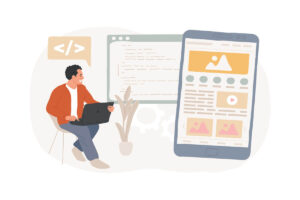In the realm of mobile application development, the user interface (UI) plays a pivotal role in determining an app’s success or failure. Lately, iPhone app developers are increasingly adopting a declarative UI design approach, marking a significant shift from the traditional imperative methods. This blog explores why the declarative UI has become the interface design paradigm of choice, highlighting its advantages in the context of iOS development. It also examines real-world examples, challenges, and considerations associated with declarative UI design and its future in iPhone app development.
The Evolution of UI Design in iOS Development
The landscape of User Interface (UI) design within iOS development has undergone significant transformations, moving from traditional imperative approaches to the more streamlined and intuitive declarative UI design. Initially, iPhone app developers heavily relied on imperative UI design, where they had to explicitly define every step required to create UI elements and how they should operate. This method, while effective, often led to lengthy and complex codebases, making them harder to read, maintain, and update.
With the introduction of SwiftUI by Apple in 2019, a paradigm shift towards declarative UI design began. Declarative UI simplifies the development process by allowing developers to state what the UI should do, rather than how to do it. This approach provides a more intuitive and straightforward way to create dynamic and interactive user interfaces, resulting in faster development cycles. As a result, declarative UI has quickly gained popularity and become the go-to design paradigm for most iOS developers.
Key Benefits of Declarative UI Design for iPhone Apps
Declarative UI design offers several advantages over traditional imperative approaches, making it the preferred choice among iPhone app developers. Here are some of the key benefits:
Simplified Codebase
One of the most significant advantages of declarative UI is its ability to significantly reduce the complexity and the number of lines of code required to build interfaces. By focusing on what the interface should do, rather than how it should be done, iPhone app developers can create complex UIs with fewer lines of code. This not only makes the codebase more manageable but also enhances code readability and maintenance.
Faster Development Cycle
The simplicity of declarative UI directly translates to faster development cycles. iPhone app developers can swiftly prototype and iterate on their designs without getting bogged down in the details of implementation. This efficiency is particularly beneficial in agile development environments, where time to market can be drastically reduced.
Enhanced Performance
Applications built using declarative UI frameworks like SwiftUI tend to exhibit improved performance and a more responsive user experience. This is because the framework optimizes the underlying rendering and processing tasks, ensuring that only the necessary components are updated when changes occur. This optimization leads to smoother animations and transitions, providing users with a more fluid experience.
Streamlined Collaboration Between Developers and Designers
Declarative UI bridges the gap between developers and designers, facilitating a more collaborative and efficient workflow. Designers can easily conceptualize interfaces, which developers can then implement more straightforwardly, without the need for extensive back-and-forth. This synergy not only accelerates the development process but also ensures that the final product aligns closely with the original design vision.
According to a report by Medium, the adoption of SwiftUI among developers increased within a year of its release, highlighting the growing preference for declarative UI in iOS development.
This statistic underscores the effectiveness and efficiency of declarative UI design, solidifying its position as the future of iPhone app development.
Challenges and Considerations
While the shift towards declarative UI design brings numerous advantages, it is not without its challenges. One significant concern for iPhone app developers and best mobile app developers is the learning curve associated with adopting new paradigms and technologies. Developers accustomed to imperative programming models may find it challenging to adapt to a declarative approach. Additionally, there are considerations regarding backward compatibility and ensuring that applications built with cutting-edge frameworks like SwiftUI run smoothly across all supported iOS versions.
To mitigate these challenges, development teams must invest in training and knowledge sharing. Establishing a culture of continuous learning and exploration can help teams stay ahead of the curve. Furthermore, leveraging online communities and resources can provide invaluable support and insights as developers navigate the intricacies of declarative UI design.
The Future of Declarative UI Design in iPhone App Development
The future of iOS development is promising, with declarative UI design poised to play a pivotal role. As more iPhone app developers and best mobile app developers embrace these frameworks, we can expect a surge in innovative and user-friendly applications. The essence of declarative UI simplifying the development process while enhancing app performance aligns perfectly with the demands of modern app users for snappy, intuitive experiences.
In the coming years, we may see an even greater emphasis on tools and frameworks that automate and streamline the development process, allowing developers to focus more on creativity and user experience. This evolution could lead to a new era of app development where the gap between a concept and its realization is narrower than ever before. Indeed, the adoption of declarative UI design marks a significant step towards achieving this vision, setting the stage for the next wave of breakthroughs in iPhone app development.
Conclusion
The shift towards declarative UI design among iPhone app developers signifies a broader trend in software development toward more efficient, collaborative, and user-centric approaches. By simplifying codebases, speeding up the development cycle, and enhancing app performance, declarative UI design is set to remain a key driver in the evolution of mobile application development. As the demand for faster, more intuitive apps continues to grow, the role of declarative UI design will only become more critical. With its ability to empower developers and create better user experiences, this approach is undoubtedly here to stay in iPhone app development and beyond. So, Reach out to us to learn more about how we can help you leverage the power of declarative UI design for your next app project.











+ There are no comments
Add yours